Bulletin – March 2019 Global Economy Housing Policy and Economic Growth in China
- Download 621KB
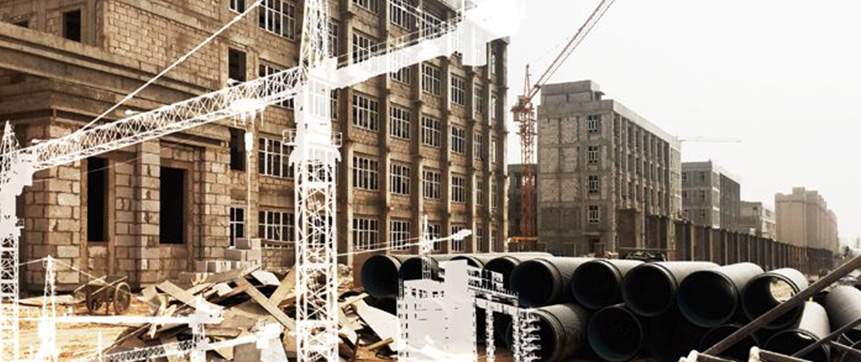
Abstract
Housing investment has contributed significantly to Chinese GDP growth in recent decades and, due to the steel-intensive nature of that investment, has also been an important driver of Australian exports of iron ore and metallurgical coal. Trends in Chinese residential investment have been strongly influenced by government policies. Since 2016, the Chinese Government has tightened policies, particularly towards ‘speculative’ housing purchases, to moderate property price inflation. It has simultaneously implemented targeted, incremental measures to improve longer-term housing supply. Even so, construction activity has weakened and prices have continued to rise rapidly. Maintaining this policy mix towards the sector is likely to prove challenging as downside risks to broader economic conditions mount.
Background: Property Cycles and Growth
China's residential property sector has been transformed in recent decades but the government continues to play a role in guiding markets. Starting in the 1990s, residential housing, which had formerly been allocated by the state in urban areas, was privatised. This led to the creation of an active property market, an emerging market for mortgage credit and rapid housing price inflation. The expansion of the private market, however, also fuelled concerns about wealth inequality and affordability, which has prompted the government to boost the construction of social housing to supplement the role of the private market in housing allocation (Yang and Chen 2014). Private property markets continue to be strongly affected by government policies, many of which are periodically changed to affect the demand for (and supply of) housing to help smooth economic growth and temper large swings in housing prices (Graph 1).
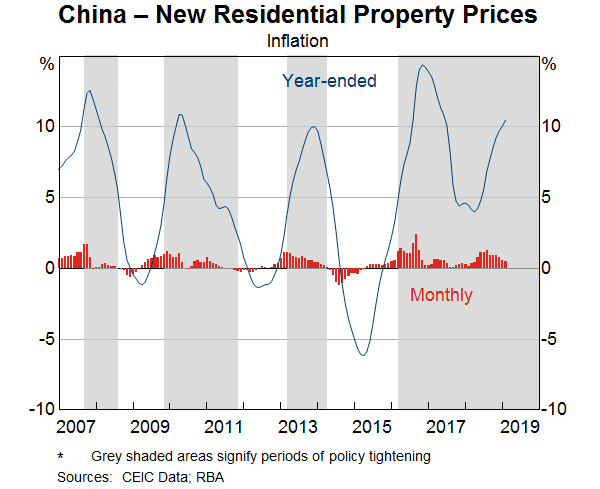
In recent years, there have been several distinct episodes of policy intervention. In 2007, 2009, 2013 and 2016, the government tightened policies on housing purchases and related borrowing to control rapid increases in prices. In each episode, restrictions were placed on the number of apartments households could purchase. These restrictions were often linked to households' residency status (or hukou) in the locations where they intended to purchase property. For example, the number of home purchases would be determined by a household's possession of local residency or other evidence of long-term residence, such as documentation of local tax payments. Authorities also introduced higher mortgage rates and lower loan-to-value ratio (LVRs) (higher down payment) requirements for investment or second home purchases to dampen speculative demand, which was broadly defined as purchases for investment rather than use.[1] The government also attached minimum ownership periods of two to five years before the property could be resold, to disincentivise speculative purchases (Wang 2017, Deng and Zheng 2018).
Typically, when it became clear that tighter policies were weighing too heavily on prices and construction activity, the authorities responded by raising LVRs, introducing mortgage rate discounts and increasing tax exemptions to stimulate construction activity. This approach is illustrated by the 2014–16 episode, which initially recorded a sharp fall in property prices followed by a strong recovery. In response to lower prices, persistent falls in sales and a large stock of unsold housing that had accumulated following earlier construction booms, a large number of smaller (‘second-tier’ and ‘third-tier’) cities eased mortgage requirements and housing purchase restrictions in 2014.[2] In March 2015, the People's Bank of China announced a national easing in lending policies for housing purchases (PBC 2015). As a result, sales recovered strongly (Graph 2). The rebound was augmented by the introduction of more direct policies to support purchases, such as subsidies for home buyers in some smaller cities. In many small cities, the rebound was also supported by strong demand from investors, due to the lack of hukou-based restrictions on purchasing property in these locations. Sales in second- and third-tier cities strengthened further after the stock market crash in mid 2015 and into late 2015 when capital controls were tightened; down payment requirements were eased further at this time. This easing over 2015 also successfully reduced the stock of unsold housing.
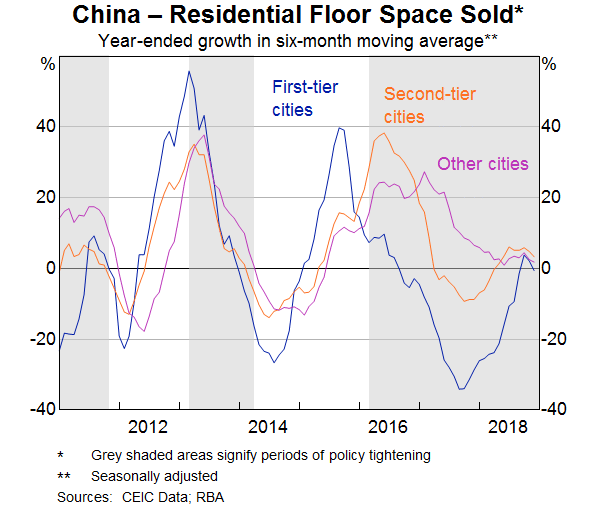
Periodic tightening and loosening episodes have had a pronounced effect on Chinese residential fixed asset investment. These policy cycles have also had non-trivial effects on GDP growth in China due to the wide range of upstream and downstream industries that facilitate construction and sales (including steel, cement, glass, household fittings and financial services related to housing). Extending earlier research by Xu et al (2015), which exploits input-output tables provided by China's National Bureau of Statistics, we estimate the upstream and downstream contribution to GDP growth of real estate (including both residential and commercial) investment.[3] Combining the direct and indirect effects of real estate investment on activity, our estimates suggest that, on average, from 2003 to 2017 real estate investment contributed 2 percentage points to GDP growth – that is, just over one-fifth of the average increase in real GDP (Graph 3).[4] This contribution peaked following the government's policy stimulus in response to the global financial crisis; real estate investment accounted for almost half of GDP growth in 2010. In other periods, fluctuations in the contribution of real estate investment to GDP growth have also been broadly aligned with major changes in government policies affecting the residential property market, albeit to a lesser extent.
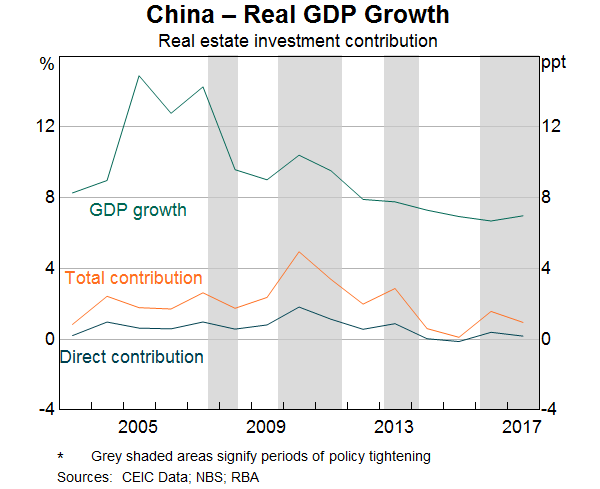
These sizeable real effects of policies towards the housing market underscore the importance of understanding these policies when considering the outlook for Chinese growth, steel production and demand for Australia's bulk commodities. In light of this, in the next two sections we explore recent changes in Chinese Government policies with respect to the housing market. First, we consider how the policy approach adopted by authorities since 2016 to control residential property demand and prices has affected market outcomes and how these trends have differed across different-sized cities. Second, we discuss progress made on longer-term supply-side policies and their implications for Chinese investment and growth.
The 2016 Policy Tightening and Its Effects
The most recent episode in housing market conditions can be distinguished from previous ones because property price inflation has persisted, especially in medium-sized and smaller cities, despite these cities also having introduced a large number of house purchase restrictions and tightened LVR requirements. By 2016, housing price inflation had risen sharply, and authorities had grown concerned about property price ‘bubbles’, a sharp increase in leveraged purchases of property, and related risks to financial stability. In response, in early 2016, local authorities began tightening policies again, progressively announcing more measures as housing price inflation persisted. Required down payments reached 80 per cent of the purchase price in certain locations. Many cities also introduced policies that restricted purchasers of new properties from reselling within two or three years (depending on the city) to limit ‘speculative’ purchases (Zhang 2017). The Reserve Bank of Australia's (RBA's) liaison contacts in China reported that real estate agents and developers in some cities were instructed to impose price ceilings (or ‘price caps’) on sales, and that authorities could shut down the business of developers or real estate agents in breach of these requirements.
Policymakers' resolve to tame property price inflation did not waver even when the largest (‘first-tier’) cities experienced much weaker sales growth and prices began to decline in late 2017 and early 2018 (Graph 4). Tightening policies have now been implemented in more than 100 cities that collectively account for the majority of the urban population; some commentators have claimed that the current tightening episode is the most stringent in history (Xinhua 2018)
It is likely that the continued steady rise of property prices, despite the restrictions, partly reflects the fact that tightening measures in the current episode have been highly tailored to local conditions and have been implemented in several waves. This has arguably given local governments more flexibility to avoid the sharp falls in prices observed in some earlier tightening episodes because they could tighten measures incrementally. In fact, in first-tier cities, inflation in property prices is likely to have been stronger than suggested by the data due to innovations such as the use of ‘yin yang contracts’ – secondary supplementary contracts between vendors and buyers that effectively evade price caps imposed by local governments.[5] More generally, persistent inflation in housing prices has been supported by a combination of strong investor and owner-occupier demand and relatively tight housing supply.
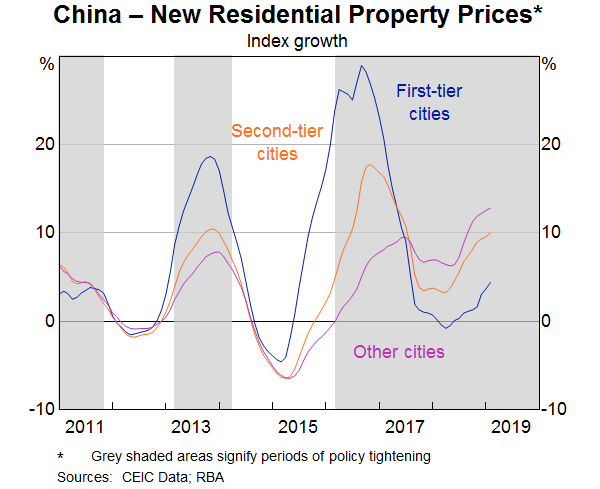
Part of the explanation for continued strong demand in medium-sized and smaller cities is that many are close to clusters of industrial activity, are relatively affordable (compared to the first-tier cities) and are seen as having significant potential for future inflation in property prices. Recent liaison in China by the Bank has highlighted that cities earmarked as being within major planned ‘city clusters’ (e.g. in the Pearl River Delta, the Yangtze River Delta, and the Beijing-Tianjin-Hebei area) have attracted particularly strong investor and owner-occupier interest and are widely expected to see further rapid property price inflation over the coming decade. Owner-occupier housing purchases have also been supported by continued population inflows from rural (and other urban) areas, cash subsidies provided under social housing programs to eligible households, and low mortgage interest rates (Wang and Zhao 2018).
New housing supply has also been slow to come on line in these second- and lower-tier cities. The relatively slow increase in supply compared to past episodes is consistent with a fall in construction activity in some areas (Graph 5).[6] Liaison contacts have reported that developers have pushed out construction time frames in the hope that completions will ultimately occur in future periods when price caps may be removed. Indeed, growth in developers' expenditure on construction has fallen noticeably in the most recent housing market episode, despite ongoing growth in land sales for new residential plots (Graph 6).[7]The slowdown in developers' activity is partly due to financing pressure faced by real estate developers (due to slower growth in sales receipts) and reduced access to ‘shadow’ financing channels due to the nationwide crackdown on non-bank financial intermediation.
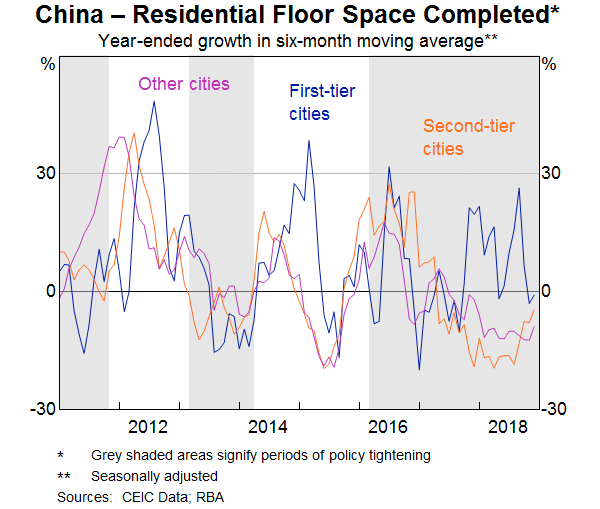
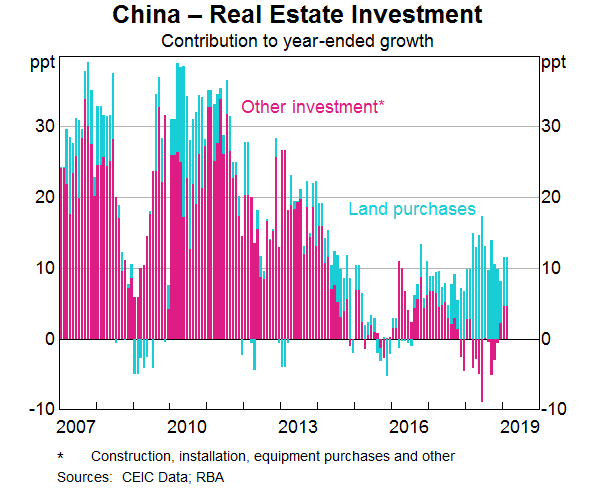
The government's reluctance to initiate a blanket easing of property market policies over the past year, despite softer economic growth, demonstrates increased willingness to reduce China's dependence on the real estate industry as an engine of growth. This aligns with the government's longer-term goals of preventing the build-up of financial risks in the property market (for example, due to leveraged housing purchases) and fostering a rebalancing of GDP growth away from investment. A related aim is to reduce local government dependence on revenues from sales of land use rights, partly through broader taxation reforms such as the planned introduction of a national annual tax based on the value of a property (Wan and Xie 2017).[8] The tight policy stance towards the property market is underscored by President Xi Jinping's repeated emphasis that ‘housing is for living in and not for speculation’ (Xi 2014). A shift in impetus away from using property sector policies to achieve macroeconomic objectives is also illustrated by the regulatory tightening of financing to developers. This crackdown, combined with slower sales receipts due to house purchase restrictions, has led to a noticeable consolidation in the industry; in 2018, the top 30 developers accounted for more than 30 per cent of sales volumes, up from 8 per cent in 2010.
Nonetheless, pressure on the authorities to relax some of the constraints on the property sector is increasing as downside risks to broader economic conditions mount. To date, there have been isolated reports of smaller cities and specific districts within larger cities offering interest rates below benchmark rates and some house purchase restrictions being eased slightly (Liu 2018 and Wang and Jia 2018). However, in recent months the central government has continued to emphasise its commitment to limiting market speculation and reducing the economy's reliance on the real estate sector (MOHURD 2018, Wang 2019). So far, most policies announced to support economic activity have focused on consumption and infrastructure investment rather than stimulating the property sector.
Longer-term Efforts to Build a Sustainable Housing Market
Taken at face value, the case for further significant policy-driven increases in housing supply in China is not obvious. Home ownership rates in China are relatively high by international standards. Academic estimates suggest that 80–90 per cent of the population in China already own a residential property (Yang and Chen 2014, Deng et al 2014).[9] In other countries, home ownership rates vary significantly, although many lie in the 60–80 per cent range (RBA 2015).[10] Moreover, simple metrics such as price-to-income ratios suggest that housing affordability in China has improved over the past decade, as rapid property price inflation has been outpaced by even stronger growth in household incomes (Graph 7). Nonetheless, Chinese policymakers have been deeply concerned about the affordability of, and access to, housing that is of a reasonable quality. This reflects concerns that a lot of housing is dilapidated or does not meet basic safety standards. It also reflects concerns about the income distribution, particularly in some of China's largest cities, where affordability has plateaued; these issues are especially acute in some of the cities that have been designated as ‘rental pilot cities’ (discussed in detail below).
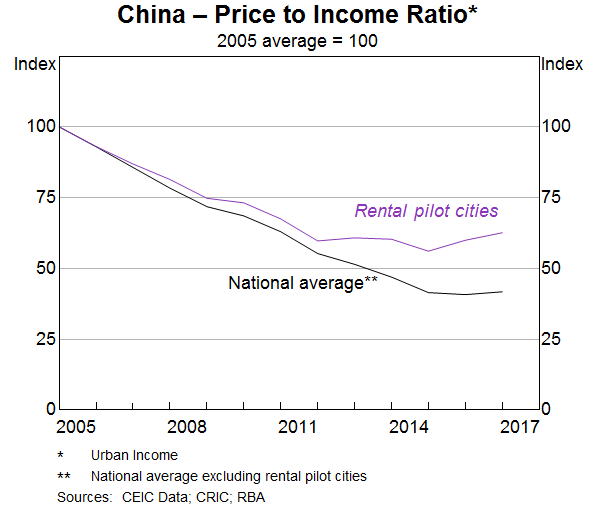
A number of issues have driven these concerns. First, a large number of households own or reside in lower-quality housing (or ‘shantytowns’). Second, significant income disparities within China mean that measured aggregate affordability ratios are unlikely to reflect the constraints or distributional issues faced by millions of households. In particular, housing is likely to be less affordable for rural-to-urban migrant workers because available data suggest that migrant workers' annual wages are only two-thirds of the national average. Housing purchase restrictions also typically impose more onerous restrictions on migrant workers, and these workers lack equal access to public rental housing. The fact that home ownership is high reflects the fact that many people own properties where they were born (often former public housing that was sold at a heavy discount to tenants during the 1990s housing reforms), but not necessarily in the cities where they live and work. Another issue is that the lack of affordable and accessible housing is especially acute for younger households (Yang and Chen 2014). Meanwhile, in an environment where housing prices have consistently risen faster than the value of other financial assets, higher income earners have had an incentive to undertake speculative investments in properties in smaller cities (many of which have not had strict hukou-based purchasing restrictions in place until recently), which has put upward pressure on prices in those cities.
To address these affordability and inequality concerns, Chinese authorities have spearheaded several initiatives in the past five years to foster a targeted increase in housing supply and improve its composition. These initiatives have significantly boosted real estate investment. One key initiative is the ‘shantytown redevelopment program’, which aims to reduce the number of people living in poorer-quality housing in less-developed areas and ‘rustbelt’ cities. Another initiative is the ‘rental pilot cities’ program, under which the government has announced a number of policies to boost the supply of public and private rental housing.[11] Rental programs seek to provide good quality, stable and safe rental accommodation in some of China's largest cities, where affordability has not improved in recent years, especially for new migrant workers (both from rural areas and other cities) and college graduates.
The shantytown redevelopment program
Redeveloping shantytowns has been the primary contributor to overall growth in social housing construction in recent years (Graph 8). Chinese authorities define ‘shantytowns’ as areas with high density simple structures, with poor functionality, limited access to infrastructure, and safety risks; these areas were mainly populated by older and lower-income groups (MOHURD 2013). Initially China's shantytowns were located near heavy industrial areas (such as coal mines) because they were constructed in the early stages of China's development to house workers from other regions. But, over time, they became more widely distributed (MOHURD 2010). Estimates by the Chinese Government suggest that investment in shantytown redevelopment alone added 0.2 percentage points per annum to GDP growth between 2015 and 2017 (State Council 2015). Using investment data from the National Audit Office, and applying the same input-output table-based method used above, we arrive at a similar estimate.
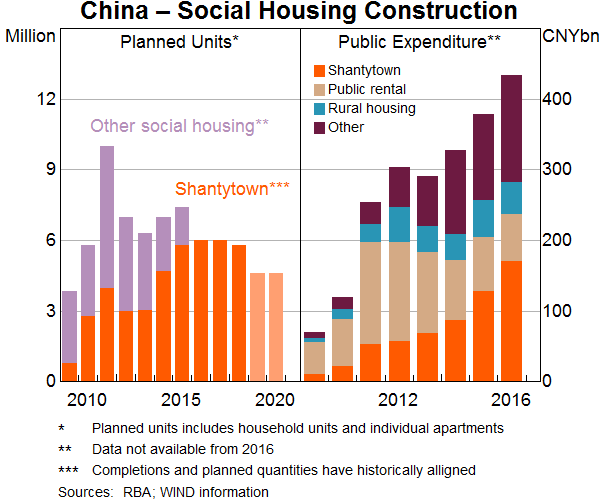
The shantytown program has also contributed directly to strong housing demand growth in recent years. Eligible existing residents are either offered a better quality, reconstructed home in place of their old home, or given cash-based compensation that can be used to purchase new housing from the market. From 2014, the government increased the use of cash-based compensation, which rose from 9 per cent of total (cash and in-kind) compensation in 2014 to 48.5 per cent in 2016 (State Council 2018a). However, analysis of survey data by the China Household Finance Survey and Research Center suggests that only 20 per cent of households receiving monetary compensation over 2013–17 used it to repurchase a primary residence for occupation. Instead, more than half of households surveyed were reported to have used it to buy secondary (or additional investment) properties.[12] In other cases payments were reportedly used to support consumption, purchase financial assets, or pay down household debts.
The shantytown redevelopment program is due to be completed in 2020, which, all else being equal, will reduce future growth in real estate investment. Announcements in late 2018 indicated that remaining investment under the program would become more targeted, partly reflecting concerns that public funding intended to help resettle impoverished families has been poorly directed in some cases (State Council 2018c).[13] To better target investment under the program, the central government has directed local governments in parts of the country with low developer inventories to replace compensation payments with in-kind compensation (in the form of a replacement dwelling) (State Council 2018b).[14] While the government has foreshadowed a slight further acceleration in shantytown reconstruction in the very near term, there are currently no plans to significantly broaden or extend the program. Authorities have emphasised that they are seeking to deliver a ‘multifunctional’ housing market that also encompasses alternatives to owning property.
Boosting the supply of rental housing
Another key agenda item for the Chinese Government is to improve the volume and quality of rental housing. Only around 5–10 per cent of China's housing stock is estimated to be rented (Deng et al 2014, Peppercorn and Taffin 2014). This is low compared to many other developing and advanced economies. The small private share of the rental housing stock in part reflects the fact that until recently there have been limited market incentives for real estate developers to construct and manage rental housing themselves. Low rental yields in large cities have made cost recovery difficult and the boom in property prices has further incentivised developers to focus on sales, which have accounted for the bulk of developers' income in the past decade (Graph 9).

In January 2017, 13 cities – mainly first-tier cities and provincial capitals located around the coastal fringe and clustered around first-tier cities – were designated as ‘rental pilot cities’ by the central government. This designation means that these cities now have obligations to the central government to accelerate development of their rental markets by 2020. Most of the official pilot cities announced are among China's most populous cities and all of these cities have tightened access to housing purchases over the past three years. Specific policies to deliver on these obligations are being determined and implemented at the city level. As such, policies vary by city, allowing them to be calibrated to local needs (Table A1 compares key policies by pilot city). Designated cities submitted pilot plans to the Ministry of Land and Resources and the Ministry of Housing and Urban Construction in 2017 and the implementation of these pilots will be reviewed at the end of 2020. More recently, an additional five second-tier cities have also been slated to develop rental programs (Du 2019).
The rental pilot program will support investment in coming years, but by how much is uncertain. A couple of the rental pilot cities included targets for the number of unit completions in their pilot plans, but these ranged from 20,000 to close to 200,000, and most cities did not include specific numbers. Some local governments are using their control over land supply to achieve these targets. For example, in Guangzhou, Fuzhou, Xiamen and Hangzhou, around 25–30 per cent of land releases for new housing are to be demarcated for rental purposes only. Some other cities, such as Hefei, are dedicating around one-sixth of new housing to rental accommodation. In some instances, conditional price ceilings at land auctions have been imposed to foster growth in the supply of rental housing. Liaison by the Bank suggests that when bidding reaches 1.7 times the starting bid, the auction is terminated and the purchaser is forced to hold the land and prohibited from reselling apartments built on the land for up to 70 years. In response to these ‘bid caps’, developers have an incentive to increase the share of their developments devoted to rental properties in an attempt to make their bid more attractive to local authorities.
Authorities are also facilitating rezoning of underutilised land to contribute to the supply of rental properties. In their pilot plans, the majority of local governments announced that developers and state-owned enterprises would be permitted to convert idle or underutilised factories and commercial spaces into rental housing.[15] While these conversions will contribute to investment and construction activity, they are unlikely to be as steel-intensive as newly built apartments. In addition, developers that have large stocks of unsold residential property designated for private sale in second-tier cities are being encouraged to repurpose these properties as rental housing, which seems unlikely to make much, if any, contribution to construction activity.
Authorities are also trying to take advantage of China's well-developed e-commerce infrastructure and related ‘big data’ sets to reduce information asymmetries. One of the obstacles new measures are seeking to overcome is that much of the rental market to date has been informal and fractured. As a result, large companies are now being enlisted to create more centralised online rental markets. Large online portals for rental listings (including listing property features and prices) are being launched, which also include information on landlord and tenant ratings histories. Property managers are working with large e-commerce providers to use digital wallet credit scores (based on shopping data) to identify creditworthy renters; in some cases those with good credit scores will also have the typical deposit requirement of three months' rent waived. Several of China's largest banks have also launched products that will see renters granted loans to help them make the upfront payments necessary to secure longer-term leases (some reports suggest previous leases may have had to be renewed every three to six months).[16]
A separate group of initiatives seeks to encourage growth in the private rental stock by incentivising individual landlords to put their second or third properties (i.e. investment properties) on the rental market. Reforms include proposals to reduce taxes on rental income and to remove restrictions on homeowners' use of unoccupied properties.[17] However, the time frame for implementation of these measures remains uncertain and it is not clear they will be sufficient to incentivise owners to start renting out their properties. Most city-level plans identify, as a priority, development of additional large-scale leasing enterprises to professionally manage affordable properties to help accelerate development of rental markets and formalise rental arrangements.[18]
Conclusion: The Outlook for China's Property Markets
As in the recent past, future trends in China's property markets are likely to be strongly conditioned by the evolution of policies towards the housing sector. If the authorities succeed in simultaneously maintaining relatively tight demand-side policies, while delivering on the government's social housing objectives, this would fulfil President Xi's aspiration that housing should be ‘for living in and not for speculation’. Indeed, the current mix of tight demand-side policies and accommodative medium-to-longer-term supply-side measures should, in principle, help moderate price growth and deliver better access to housing for people who are constrained from buying their own home.
However, the authorities face a challenging policy dilemma. The strong influence of property market conditions on overall GDP growth implies that, if the current policy mix continues to deliver weak construction activity, policymakers will face incentives to ease restrictions on housing markets. This is especially the case when GDP growth is already slowing because of tighter financial regulation, as well as longer-term structural factors such as a declining working age population. At the same time, the fact that property prices have continued to rise relatively quickly in mid-sized and smaller cities, despite an unprecedented tightening of demand-side controls on purchases, means that any policy easing would increase the risk of prices picking up further, and reducing affordability.
The forthcoming phasing out of the shantytown redevelopment program, the uncertain scale of construction of new rental housing, tight financing conditions for developers, and the central government's strong resolve to maintain restrictions on home purchases despite softer economic growth over the past year, all add uncertainty to the outlook for real estate investment. If housing purchase restrictions remain in place for a protracted period, or if construction of rental dwellings falls short of expectations, the risk of a marked slowdown in real estate investment will increase. This would have wider implications for the Chinese economy and for Australian exports, particularly iron ore and metallurgical coal exports.
Appendix A
| Beijing | Chengdu | Foshan | Guangzhou | Hangzhou | Hefei | Nanjing | |
|---|---|---|---|---|---|---|---|
| Minimum land release requirements | |||||||
| Permitting conversion of retail, office and industrial properties | |||||||
| Encourages residential inventory reduction through conversions | |||||||
| Marketisation of public rental units(a) | |||||||
| Preferential access for young graduates to rental accommodation | |||||||
| Enhancing renters legal rights | |||||||
| Formalising collective land leasing arrangements | |||||||
| Shanghai | Shenyang | Wuhan | Xiamen | Zhaoqing | Zhengzhou | ||
| Minimum land release requirements | |||||||
| Permitting conversion of retail, office and industrial properties | |||||||
| Encourages residential inventory reduction through conversions | |||||||
| Marketisation of public rental units | |||||||
| Preferential access for young graduates to rental accommodation | |||||||
| Enhancing renters legal rights | |||||||
| Formalising collective land leasing arrangements | |||||||
|
(a) Policies include introducing more market-based rates for rental properties and converting some public rental housing Sources: Local government policy documents |
|||||||
Footnotes
The authors are from Economic Group. [*]
While not new, over recent years the Chinese Communist Party has frequently emphasised that the availability of adequate basic housing is a high priority, through repetition of the slogan that ‘housing is for living and not for speculation’. President Xi's view on residential housing topic was outlined in a speech in October 2013 (Xi 2014). [1]
China's cites are commonly (although not officially) referred to by hierarchical groupings of ‘first-tier’ cities (Beijing, Guangzhou, Shanghai and Shenzhen, or ‘mega’ cities), ‘second-tier’ cities (the capital cities of China's provinces, ‘medium sized’ cities), and ‘third-tier’ and below cities (‘smaller cities’, which typically are less developed and have smaller populations). [2]
The approach involves applying the ‘Leontief inverse’ method (Miller and Blair 1985) to individual official input-output tables for 2002, 2005, 2007, 2010, 2012 combined with annual estimates of real residential gross capital formation derived using the approach of Ma, Roberts and Kelly (2016). Estimates for unobserved years are produced using linear interpolation. Investment in commercial property has, on average, accounted for around one-third of real estate investment over the past decade. [3]
The indirect effects on services activity have been substantial at times. For example, growth in financial services arising from housing investment contributed almost half as much value added as industrial and consumer goods manufacturing in 2016. [4]
Liaison conducted by the Bank suggests that these supplementary contracts could be worth around 40 per cent of the ‘real price’ (which is not captured by price data). While ‘yin yang contracts’ are thought to have been most pervasive in first-tier cities, liaison conducted by the Bank suggests that their use has spread to some of the capital cities of provinces throughout China in the most recent episode. [5]
The fairly sharp recovery in inventories in first-tier cities from mid 2017 follows some urging from local authorities for progress to be made on projects (Beijing Municipal Commission of Housing and Urban-Rural Development 2017b). [6]
While this measure also includes developers' investment expenditure on commercial property, more than two-thirds is related to residential property. [7]
Following the 19th National Congress of the Chinese Communist Party in 2017, Finance Minister Xiao Jie published an op-ed article suggesting that China's long-awaited national property tax (which has been under development for several years) could be implemented by 2020. However, uncertainty remains as to the date of introduction and the design of the tax (e.g. the rate at which properties will be taxed). [8]
In recent years the Chinese government has been building a land title registry to record actual ownership holdings for both primary residences and investment properties, which will generate more precise ownership rates and support introduction of a national property tax. [9]
Land ‘ownership’ is complicated in China with the use rights attached to titles varying between rural and urban residents, meaning that cross-country comparisons are, however, not strictly equivalent. [10]
Previous policies have primarily focused on public (i.e. government subsidised) rental housing (Yang and Chen 2014 and Deng et al 2014). [11]
Many others are thought to have used these compensation payments to supplement income and fund consumption over this period (Gan 2018). [12]
Since 2007, local governments have also financed public housing with proceeds from land sales (Yang and Chen 2014). [13]
Central authorities also emphasised the need for more careful fiscal planning at the local level to support the program, and authorised the use of local government ‘special bond’ issuance to help fund the rest of the program. [14]
In Guangzhou, it was foreshadowed that converted properties would be subject to restrictions on their resale (General Office of Guangzhou Municipal People's Government 2017). [15]
For example, in November 2017, China Construction Bank began granting loans of up to CNY1 million so that renters could make one-off down payments of several years' worth of rent to secure multi-year leases (China Construction Bank 2018). [16]
Previous liaison conducted by the Bank in China suggests that, generally, rental income taxes vary by city but in some cases the rate is close to 20 per cent, including income, business and value added taxes (VAT). The taxation bureaus in some cities have lowered the VAT on rental income from 5 per cent to 1.5 per cent for individual landlords with rental income less than CNY30,000 per month. Professionally managed rental intermediary services will also be able to apply lower VAT rates on rental income. Introduction of national annual tax based on the value of a property may further encourage owners to rent out empty properties. [17]
Some of these leasing companies are to be state-owned enterprises and in other cases subsidiaries of property developers, although several cities also explicitly note that small and medium-sized professional property managers would also be beneficial. A few cities have included minimum targets for the number of leasing companies. [18]
References
Beijing Municipal Commission of Housing and Urban-Rural Development (2017a), ‘Decree No 21’ [in Chinese], 29 September. Available at <http://www.bjjs.gov.cn/bjjs/fwgl/fdcjy/tzgg/433559/index.shtml>
Beijing Municipal Commission of Housing and Urban-Rural Development (2017b), ‘Notice of the Beijing Municipal Housing and Urban-Rural Development Committee on Matters Relating to the Handling of Pre-sale Permits for Commercial Residential Projects’ [in Chinese], 27 June. Available at <http://www.bjjs.gov.cn/bjjs/fwgl/fdckfgl/csjggs/426534/index.shtml>
China Construction Bank (2018), ‘People's Daily: Paying rent, are you willing to Lend?’ [in Chinese], 25 January. Available at <http://ccb.com/cn/ccbtoday/media/20180125_1516867249.html>
Deng W, J Hoekstra and M Elsinga (2014), ‘Urban Housing Policy Review of China: from Economic Growth to Social Inclusion’, Conference Paper, Annual Conference of European Network of Housing Research, Edinburgh.
Deng Z and J Zheng (2018), ‘More than a Hundred “Regulatory Orders”, is it Difficult to Restrain the Property Market “Flaming Mountains”?’ [In Chinese], 13 July. Available at <http://www.xinhuanet.com/fortune/2018-07/13/c_1123121891.htm>
Du Y (2019) ‘Plans to Extend the Collective Land Construction and Rental Pilot to Five Cities to Offset Regional Property Price Increases’ [in Chinese], 17 January. Available at <http://www.cs.com.cn/cj/fcgs/201901/t20190117_5916122.html>
Foshan Municipal People's Government Office (2018), ‘Decree No 21 2018’ [in Chinese], 9 July. Available at <http://www.foshan.gov.cn/zwgk/zfgb/rmzfbgswj/201807/t20180720_7161123.html>
Gan L (2018) ‘Why Should we Persist with Monetisation?’ [in Chinese], 2 July. Available at <http://finance.sina.com.cn/zl/china/2018-07-02/zl-ihespqry6408002.shtml>
General Office of Guangzhou Municipal People's Government (2017), ‘Decree No 29’ [in Chinese], 30 June. Available at <http://www.gz.gov.cn/GZ00/2.3/201707/3cec198881d44d33a80a145ff024a164.shtml>
General Office of Nanjing Municipal People's Government (2017), ‘Decree No 152’ [in Chinese], 15 August. Available at <http://nj.house.sina.com.cn/news/zhengce/2017-08-18/17206304240315364854898.shtml>
General Office of the Fujian Provincial People's Government (2016), ‘Decree No 182’ [in Chinese], 29 November. Available at <http://www.fujian.gov.cn/xw/ztzl/qyjrdd/szfbgtwj/201611/t20161129_1180128.htm>
General Office of the People's Government of Chengdu (2017), ‘Decree No 49’ [in Chinese], 7 April. Available at <http://gk.chengdu.gov.cn/govInfoPub/detail.action?id=89255&tn=6>
General Office of the People's Government of Guangdong Province (2017), ‘Decree No 7’ [in Chinese], 23 January. Available at <http://www.gz.gov.cn/088221675/2.1/201702/2f1f79fc9a5844c39824042c846b967b.shtml>
Hangzhou Municipal People's Government Office (2017), ‘Decree No 4’ [in Chinese], 29 August. Available at < http://www.hangzhou.gov.cn/art/2017/9/13/art_1302349_4155.html>
Hefei Municipal People's Government (2017), ‘Decree No 175’ [in Chinese], 31 October. Available at <http://zwgk.hefei.gov.cn/zwgk/public/spage.xp?doAction=view&indexno=002991856/201710-00158&name1=%D5%FE%B2%DF%CE%C4%BC%FE&name2=%CA%D0%D5%FE%B8%AE%CE%C4%BC%FE>
Liu J (2018), ‘China Softens Tone on Property Market as Economic Growth Slows’, 26 December. Available at <https://www.caixinglobal.com/2018-12-26/china-softens-tone-on-property-market-as-economic-growth-slows-101363308.html>
Ma G, I Roberts and G Kelly (2016), ‘A Rebalancing Chinese Economy: Challenges and International Implications’, Proceedings of a Conference: Structural Change in China: Implications for Australia and the World, Reserve Bank of Australia, Sydney.
Miller RE and PD Blair (1985), Input–Output Analysis: Foundations and Extensions, Cambridge University Press: Cambridge.
MOHURD (Ministry of Housing and Urban-Rural Development) (2010), ‘Notice on the Preparation of Housing Security Planning’ [in Chinese], 11 June. Available at <http://www.mohurd.gov.cn/wjfb/201006/t20100613_201322.html>
MOHURD (2013), ‘Interpretation of “State Council's Opinions on Accelerating Shantytown Redevelopment Work”‘ [in Chinese] 12 July. Available at <http://www.gov.cn/zwhd/2013-07/12/content_2445702.htm>
MOHURD (2018), ‘Seven Ministries and Commissions, Including the Ministry of Housing and Urban-Rural Development, Jointly Launched a Special Campaign to Control the Chaos in the Real Estate Market’ [in Chinese], 28 June. Available at <http://www.mohurd.gov.cn/xwfb/201806/t20180628_236582.html>.
People's Bank of China (2015), ‘Notice from a Meeting of the People's Bank of China, Ministry of Housing and Urban-Rural Development, China Banking Regulatory Commission Regarding Relevant Issues Concerning the Individual Housing Loan Policy’ [in Chinese], 31 March. Available at <http://www.pbc.gov.cn/goutongjiaoliu/113456/113469/2811338/index.html>.
Peppercorn, IG and C Taffin (2013), ‘Rental Housing: Lessons from International Experience and Policies for Emerging Markets’, Directions in Development, Washington, DC: World Bank.
RBA (Reserve Bank of Australia) (2015), ‘Home Ownership Rates’, Submission to the House of Representatives Standing Committee on Economics' Inquiry into Home Ownership, June. Available at <https://www.rba.gov.au/publications/submissions/housing-and-housing-finance/inquiry-into-home-ownership/home-ownership-rates.html>.
Shanghai Municipal People's Government Office (2017), ‘Decree No 49’ [in Chinese], 15 September. Available at <http://www.shanghai.gov.cn/nw2/nw2314/nw2319/nw10800/nw39221/nw41487/u26aw53715.html>
Shenyang Municipal People's Government Office (2017), ‘Decree No 53’ [in Chinese], 20 July. Available at <http://www.shenyang.gov.cn/zwgk/system/2017/07/24/010188511.shtml>.
State Council (2015), ‘The Investment in Shantytowns is Expected to Exceed 10 Trillion Yuan’ [in Chinese], 2 September. Available at <http://www.gov.cn/wenzheng/2015-09/02/content_2923041.htm>.
State Council (2018a), ‘Has the Shantytown Reform Policy Changed? The Target has not Changed, and Steady Progress is Being Made’ [in Chinese], 13 February. Available at <http://www.gov.cn/xinwen/2018-02/13/content_5266399.htm>.
State Council (2018b), ‘Li Keqiang Presided over the State Council Executive Meeting to Determine the Measures to Improve the Export Tax Rebate Policy and Accelerate Tax Rebates’ [in Chinese], 8 October. Available at <http://www.gov.cn/premier/2018-10/08/content_5328559.htm>.
State Council (2018c), ‘The Shantytown Reform is a Major People's Livelihood Project and also a Development Project’ [in Chinese], 11 October. Available at <http://www.gov.cn/xinwen/2018-10/11/content_5329676.htm>.
Wan P and L Xie (2017), ‘Scholars Interpret: Housing is for Living in, Not for Speculation’ [in Chinese], 6 February. Available at <http://theory.people.com.cn/n1/2017/0206/c40531-29059847.html>.
Wang J and Denise Jia (2018), ‘Mortgage Rates Fall in December in Multiple Cities’, 27 December. Available at <https://www.caixinglobal.com/2018-12-27/mortgage-rates-fall-in-december-in-multiple-cities-101363791.html>.
Wang J (2017), ‘Regulation, Let the Property Market Return to Rational’ [in Chinese], 14 August. Available at <http://www.gov.cn/xinwen/2017-08/14/content_5217572.htm>.
Wang J (2019), ‘The Word “Stable” is the First Word in the Real Estate Market’ [in Chinese], 2 January. Available at <http://house.people.com.cn/n1/2019/0102/c164220-30498692.html>.
Wang Y and F Zhao (2018), ‘Prevent and Control the Real Estate Market Risk in Second–tier Cities’ [In Chinese], 30 May. Available at <http://jjckb.xinhuanet.com/2018-05/30/c_137216321.htm>.
Wuhan Municipal People's Government (2017), ‘Decree No 39’ [In Chinese], 29 August. Available at <http://www.wh.gov.cn/hbgovinfo_47/szfggxxml/zcfg/gfxwj/201709/t20170901_134218.html>.
Xi J (2014), The Governance of China, pp.212–214, Foreign Language Press, Beijing.
Xinhua News Agency (2018), ‘Will Policy Adjustment Cool the Property Market?’ [In Chinese], 21 December. Available at <http://www.xinhuanet.com/house/2018-12-21/c_1123883163.htm>.
Xu X, H Jia and J Li (2015), ‘On the Role Played by Real Estate in the Growth of China's National Economy’ [In Chinese], Social Sciences in China, 2015(1), pp 84–101.
Yang Z and Chen J (2014), Housing Affordability and Housing Policy in Urban China, Springer, United States of America.
Zhang H (2017), ‘Exploring the “Big Truth” Behind House Purchase Restrictions’ [In Chinese], 26 September. Available at <http://finance.sina.com.cn/zl/china/2017-09-26/zl-ifymfcih5337745.shtml?cre=financepagepc&mod=f&loc=1&r=1&doct=0&rfunc=100>.
Zhaoqing Municipal People's Government Office (2017), ‘Decree No 457’ [In Chinese], 27 August. Available at <http://zwgk.zhaoqing.gov.cn/zq310/201709/t20170908_473907.html>
Zhengzhou Municipal People's Government Office (2017), ‘Decree No 43’ [In Chinese], 7 August. Available at <http://public.zhengzhou.gov.cn/u/cms/www/201708/181549498zuv.pdf>.